ISSN 2348-313X (Print)
International Journal of Life Sciences Research ISSN 2348-3148 (online)
Vol. 10, Issue 3, pp: (1-7), Month: July - September 2022, Available at: www.researchpublish.com

ISSN 2348-313X (Print)
International Journal of Life Sciences Research ISSN 2348-3148 (online)
Vol. 10, Issue 3, pp: (1-7), Month: July - September 2022, Available at: www.researchpublish.com
PG & Research Department of Chemistry, Gobi Arts & Science college (Autonomous), Gobichettipalayam - 638453, Erode Dt, Tamilnadu, India.
DOI: https://doi.org/10.5281/zenodo.6833367
Published Date: 14-July-2022
Abstract: Batch experiments are carried out for the sorption of Basic Fuchsin onto raw fruit waste. The parameters studied are agitation time, initial dye concentration, adsorbent dose, pH, temperature, The adsorption followed second order kinetics. The equilibrium data are fitted to the Langmuir and Freundlich isotherm equations. The adsorption of dye increased with increase in temperature from 302K to 322K indicated the process endothermic and spontaneous. Desorption studies show that adsorption of dye on fruit waste is chemisorpic.
Keywords: Fruit waste, Basic Fuchsin, Adsorption Isotherm, Kinetics.
Coloured waters are objectionable on aesthetic grounds for drinking and other agricultural purposes. Wastewater from dyeing industries are released into near by land or rivers without any treatment because the conventional treatment methods are not cost effective in the Indian content. Adsorption is one of the most effective method and activated carbon is the preferred adsorbent widely used. Recognising the economic drawback of dyes, commercial activated carbon [1] many investigators have been studied the feasibility of using inexpensive alternative materials which include almond shells, pinebark, woolwaste, orangepeel, lemonpeel, jack fruit peel, etc., as carbonaceous precursors for the removal of dyes from wastewater[2].
Waste fruit residues obtained from juice processing industry after the removal of impurities (washed with dil. HCl ,distilled water and dried) were used as biosorbent for the removal of basic dye. They were ground and sieved to particle size 0.200mm – 0.300mm. The reagents were used were all of analytical grade (AR). All pH measurements were made on Deluxe pH Meter(Model 101E) and colorimetric estimations were carried out on UV-Visible Spectrophotometer 119 (Systronics). A stock solution of dye was prepared using doubly distilled water. Various dye solutions with different initial concentration were prepared by diluting the stock solution. The adsobate used in this study is Basic Fuchsin.
Physico chemical characteristics of the prepared adsorbent were studied as per the standard testing methods [3] The results are reported in Table -1.Infrared Spectroscopy provides information on the chemical structure of the adsorbent. The surface morphology of adsorbents were visualized via Scanning Electron Microscopy (Fig.1).
ISSN 2348-313X (Print)
International Journal of Life Sciences Research ISSN 2348-3148 (online) Vol. 10, Issue 3, pp: (1-7), Month: July - September 2022, Available at: www.researchpublish.com
Figure
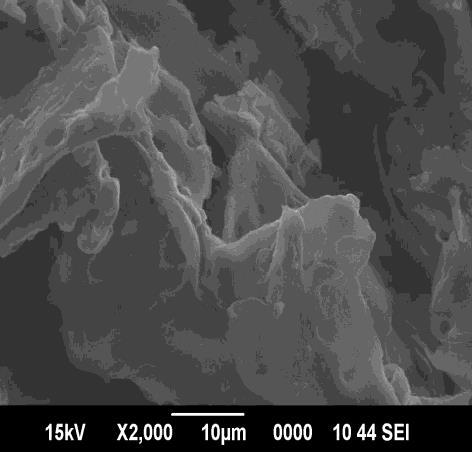
Entire batch mode experiments were carried out by taking 50mL of the dye solution and known amount of the adsorbent in conical flask. The flasks were then agitated at 120rpm for pre-determined time intervals using mechanical shaker at 302K.The adsorbent and adsorbate were separated by centrifugation. Studies on the effects of agitation time,pH,initial concentration of dye solution,adsorbent dose and temperature were carried out by using known amounts of adsorbent
Table 1: Physico chemical characteristics of the adsorbent
Sl. No Parameter
Value for FR 1 Bulk density g/ml 0.84 2 Specific gravity 0.38 3 Porosity % 54.76 4 Moisture % 13.56 5 Ash % 3.25 6 Volatile matter % 12.00 7 Solubility in water % 0.56 8 Solubility in 0.25M HCl % 2.52 9 pH zpc 5.80 10 Conductivity mS/cm 0.22 11 Decolourising power mg/g 22.44 12 Iodine number mg/g 325.84 13 Surface area m2/g 159 14 Functional groups Carboxyl group meq/g Phenolic group meq/g Lactonic group meq/g
0.162 0.258 0.043 15 Yield % 64 16 Particle size 0.200mm-0.300mm
The results ofvariationofadsorptionofBasic Fuchsin withcontact time are showninFig.2.The results revealed that,percent adsorption decreased with increase in initial dye concentration,but the actual amount of dye adsorbed per unit mass of the adsorbent increased with increase in dye concentration showing due to that the adsorption is highly dependent on initial concentration of dye[4]
ISSN 2348-313X (Print)
International Journal of Life Sciences Research ISSN 2348-3148 (online) Vol. 10, Issue 3, pp: (1-7), Month: July - September 2022, Available at: www.researchpublish.com
Adsorbent dosage is an important parameter as this factor determines the capacity of an adsorbent for a given initial concentration of the adsorbate. The effect of adsorbent dosage on basic dye removal was studied by keeping all other experimental conditions constant. The results showed that as the adsorbent concentration increased, the amount adsorbed per unit mass of the adsorbent decreased considerably[5](Fig.3).
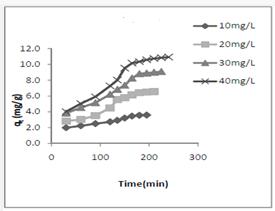
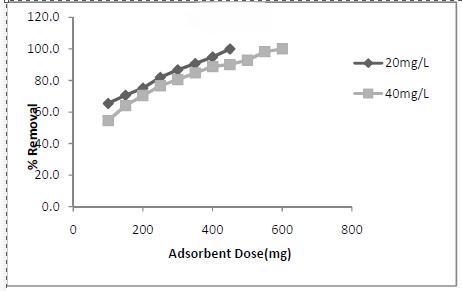
Effect of pH on adsorption of Basic Fuchsin was investigated. The results are shown in Fig.4 indicate that the percent removal increased with increase in pH [6].
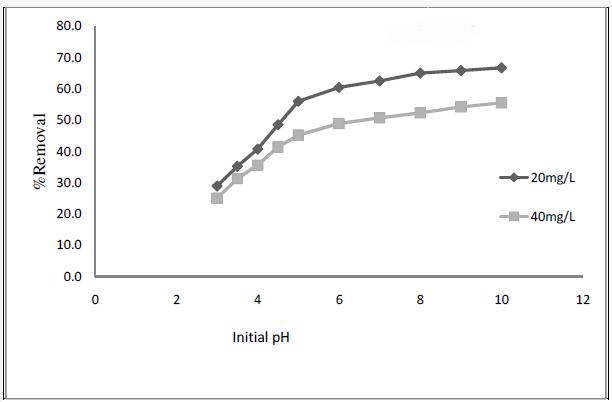
ISSN 2348-313X (Print)
International Journal of Life Sciences Research ISSN 2348-3148 (online) Vol. 10, Issue 3, pp: (1-7), Month: July - September 2022, Available at: www.researchpublish.com
Temperature has important effects on the adsorption process. As the temperature increases, rate of diffusion of adsorbate molecules across the external boundary layer and internal pores of adsorbent particle increases [7].
Several mathematical models have been applied for describing equilibrium studies for removal of pollutants by adsorption on solid surface. Out of several isotherms equations the Freundlich and Langmuir isotherm equations have been used most frequently.
The Langmuir Isotherm assumes that uptake of dye ions occurs on a homogeneous surface by monolayer adsorption. The Langmuir equation is,
Ce/qe = 1/Qob + Ce /Qo
qe - amount of dye adsorption per unit mass of adsorbent (mglg)
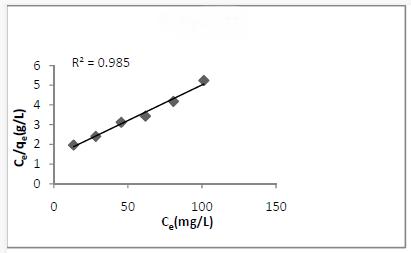
Ce - equilibrium concentration of dye (ppm)
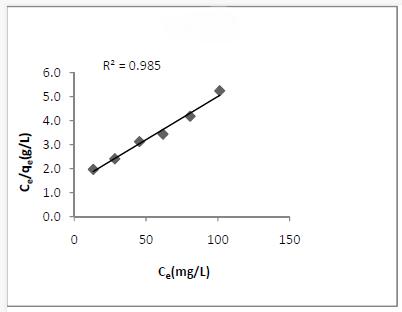
Qo - monolayer (maximum) adsorption capacity (mglg)
b - Langmuir constant related to energy of adsorption (l/mg)
The plot of Ce/qeVs Ce for the dye used was linear (Fig.5). The fact that the Langmuir isotherm fits the experimental data very well may a homogeneous distribution of active sites on the adsorbent surface [8]
The Freundlich isotherm is an empirical equation used to describe heterogeneous systems can be expressed as: log qe = log K +1/n log Ce
K - adsorption capacity
1/n - order/intensity of adsorption
ISSN 2348-313X (Print)
International Journal of Life Sciences Research ISSN 2348-3148 (online) Vol. 10, Issue 3, pp: (1-7), Month: July - September 2022, Available at: www.researchpublish.com
The plot oflogqe Vs log Ce gave a straight line (Fig.6) showing the adsorptionofBasic Fuchsin follows Freundlich isotherm [9]
Many kinetic models have been proposed to elucidate the mechanism of solute adsorption. These kinetic models are useful for the design and optimization of effluent treatment process. In order to investigate the mechanism of Basic Fuchsin dye adsorption by the adsorbent, the two kinetic models were considered.
The integrated linear form of pseudo first order kinetic model proposed by Lagergren is, log (q e - q t ) = log q e – k1 t/2.303 where q e and q t - amount of dye adsorbed at equilibrium time and at time ‘t’ respectively (mglg) k1 - first order adsorption rate constant (min -1 ) log (q e – q t) was linearly correlated with time (t). The results indicate that the reaction does not follow pseudo first order kinetics.
The adsorption may also be described by pseudo second order kinetic model [10]. The linearised form of the pseudo second order model is, t/q t =1/k 2 q e 2 + t/q e k 2 – rate constant of second order adsorption (g/mg/min)
From the results (Fig.7) it can be suggested that pseudo second order kinetics describes the adsorption of Basic Fuchsin by fruit waste much better than pseudo first order kinetic model.
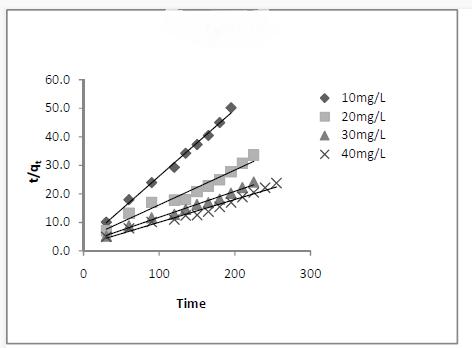
Thermodynamic parameters like ∆H◦,∆S◦ and ∆G◦ were evaluated at different temperatures using Van’tHoffs equation (Table-2).
Table
Agitation time,t(min) 302 K(% Removal) 312 K(% Removal) 322 K (% Removal) 30 18.15 25.56 35.72 60 21.82 32.57 42.56 90 27.80 39.63 48.72
ISSN 2348-313X (Print)
International Journal of Life Sciences Research ISSN 2348-3148 (online) Vol. 10, Issue 3, pp: (1-7), Month: July - September 2022, Available at: www.researchpublish.com
120 32.70 45.72 53.98 150 37.53 51.79 58.99 180 46.25 53.87 61.00 210 51.50 57.09 62.65 240 53.90 59.21 64.86
lnKc = ∆S◦/ R - ∆H◦/ RT
where, Kc is the Langmuir equilibrium constant. ∆H◦ and ∆S◦ are the standard enthalpy and entropy changes of adsorption respectively and these values are calculated from slope and intercept of the linear plot of lnKcVs 1/T. The free energy of this adsorption is calculated using the following expression.
∆G = ∆H -T ∆S
The values of Kc increased with increase in temperature indicates the endothermic nature of removal process. The negative standard free energy of adsorption confirms that the adsorption is favourable and spontaneous in nature.
Desorption studies with organic acid revealed that the regeneration of adsorbent was not satisfactory, which indicates the chemisorptive nature of adsorption.
In this work fruit waste has been used successfully as an adsorbent for the removal of Basic Fuchsin dye from aqueous solution. Adsorption was influenced by various parameters such as initial dye concentration, adsorbent dose, initial pH and temperature.
Removal efficiency increased with decreasing the dye concentration, increasing adsorbent dose and increasing the temperature. The Langmuir and Freundlich adsorption isotherm models were used for the description of the adsorption equilibriumofBasic Fuchsindye onto fruit waste. The datawere ingood agreement with Langmuir isothermand Freundlich isotherm. It was shown that the adsorption of basic dye(Basic Fuchsin) best fitted with Pseudo second order kinetic model than pseudo first order kinetic model. The thermodynamic studyreveals that the adsorptionprocess is spontaneous innature, endothermic and increased randomness at the solid solution interface of the dye and adsorbent. Desorption studies reveal that the regeneration of adsorbent was not satisfactory, which shows the chemisorptive nature of adsorption.
The author highly thankful to the Management, the Principal and Dean of Gobi Arts & Science College(Autonomous), Gobichetipalayam, Erode (Dt) for providing research facilities and giving constant encouragement.
[1] Mittal.A, Krishna.L and Gupta.V.K..Removal and recovery of Malachite green from waste water using an agricultural waste material, de-oiled soya, Sep. Puri. Tech., 43(2), 125-133(2005)
[2] Sekaran.G, Shanmugasundaram.K.A, Mariappan.M, Rahavan.K.V, Adsorption of dyes by buffing dust of leather industry, Indian J.Chem. Tech., 2, 311 (1995)
[3] Methods of Sampling and tests for activated carbon used for decolourising vegetable oils and sugar solutions, Indian Standard Institute, ISI, 877 (1977)
[4] Namasivayam .C, Muniasamy.N, Gayathri.K, Rani.M and Renganathan.K, Removal of dyes from aqueous solution by cellulosic waste, Orange peel, Bio-res.Tech., 57(1), 37-43 (1996).
[5] Namasivayam .C and Yamuna.R.T ,Utilizing biogas residual slurry for dye adsorption, Amer. Dyestuff rep., Aug, 235239 (1994).
ISSN 2348-313X (Print) International Journal of Life Sciences Research ISSN 2348-3148 (online) Vol. 10, Issue 3, pp: (1-7), Month: July - September 2022, Available at: www.researchpublish.com
[6] Hema.M and Arivoli.S, Rhodamine B adsorption by activated carbon: Kinetic and equilibrium studies, Indian J of Chem.Tech.,16, 38-45 (2009)
[7] Yang,Zhi-yuan ,Kinetics and Mechanism of the adsorption of Methylene Blue onto Activated Carbon Fibres, J of China University of Mining and Tech.,18(3),437-440 (2008).
[8] KaiShen,MAGondal,RemovalofhazardousRhodaminedyefromwaterbyadsorptionontoexhaustedcoffee ground, J Saudi Chem.Soc., 1(21), s120-s127 (2017)
[9] Changxin Li, Yuan yu, QiuyueLi, HongZhong, Shuai Wang, Kinetics and equilibrium studies of phosphate removal from aqueous solution by calcium silicate hydrate synthesized from electrolytic manganese residue, Adsorption Sci. Tech., 37(7-8), 547-565 (2019)
[10] Candelaria T Ejada- Tovar, Angel Villabona – Ortiz and Angel Dario Gonzalez – Delgado, Adsorption of Azo –Anionic Dyes in a Solution Using Modified Coconut (Cocos nucifera) Mesocarp: Kinetic and Equilibrium Study, water, 13 (1382)(2021).